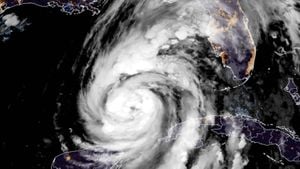In the quiet depths of freshwater lakes, an ancient biological story is unfolding, revealing the secrets of our Earth's climatic and geohydrological past. Researchers Ngugi and colleagues have delved into the genomic evolution of ammonia-oxidizing archaea (AOA) from various lakes to understand how these key microorganisms have adapted to historical environmental changes. This key piece of research not only sheds light on the history of these microorganisms but also has significant implications for water quality and nutrient cycling in modern ecosystems.
The ammonia-oxidizing archaea are fascinating microorganisms that play a crucial role in the nitrogen cycle, which is vital for the health of aquatic ecosystems. These tiny life forms are responsible for converting ammonia into nitrite, a process that initiates the removal of nitrogen from ecosystems, thereby preventing harmful algal blooms that can devastate aquatic food webs. Despite their small size, AOA are indispensable in maintaining the balance of nutrients in water bodies. They mostly reside in sediments and planktonic environments and are less studied in freshwater contexts compared to their marine counterparts.
The study carried out by Ngugi et al. stands out because it aligns the genetic evolution of these AOA species with significant paleoclimatic and geohydrological events. One of the most noteworthy findings is that the diversification of AOA in lakes across Europe, Africa, and Asia appears to be linked with the geological ages of these water bodies. Even more fascinating is the correlation found between AOA evolutionary events and the major glaciation period known as 'Snowball Earth,' which occurred around 0.7 billion years ago. During this period, glaciers reached low latitudes, which are now tropical climates.
To explore the genomic evolution of AOA, the researchers used ClonalFrameML on metagenome-assembled genomes (MAGs) of archaea collected from various lakes. This method allowed them to distinguish between the influences of horizontal gene transfer (recombination) and mutation on AOA evolution. Comparing high-quality gene sets from a large number of genomes, the study revealed a fascinating pattern: in freshwater lakes, the genetic diversity of AOA is primarily driven by mutations rather than gene transfer events. This suggests a quasi-clonal evolution, where mutations accumulate over time within a species rather than through new genetic material acquired from neighboring organisms.
An exceptional case was observed in the brackish waters of the Caspian Sea, where horizontal gene transfer played a more significant role compared to freshwater lakes. This indicates that the unique environmental conditions and geohydrological history of the Caspian Sea have been instrumental in shaping the genomic makeup of its resident AOA populations. This comparison underscores the impact that distinct geological settings can have on microbial evolution.
The findings are not just of academic interest but have broader implications for understanding nutrient cycling in freshwater ecosystems, which are crucial sources of drinking water globally. The study's authors highlight that these evolutionary insights could influence how we manage and protect freshwater resources, particularly in light of changing environmental conditions.
In terms of broader societal impacts, the research underscores the importance of looking into the historical adaptability of microorganisms to understand future ecological shifts. Microbial populations, such as AOA, have shown a remarkable ability to adapt to drastic environmental changes in the past. By understanding their evolution, scientists can better predict how these microorganisms might respond to current and future climate changes, potentially informing conservation strategies and water management policies.
However, like any study, there are limitations. One challenge the researchers faced was analyzing the contributions of horizontal gene transfer versus mutations in a diverse set of AOA genomes from different geographic regions. As pointed out in the research, the r/m values for freshwater AOA were generally lower than those found in fast-growing bacteria like Microcystis spp., known for harmful algal blooms, and the human pathogen Clostridium difficile. This highlights the relatively lower contribution of gene transfer and recombination in the evolution of freshwater AOA, suggesting a more clonal evolution profile. The slower growth rates and adaptation to low energy conditions of AOA are factors that might explain these findings.
Moreover, the study sheds light on the potential for further investigations into the genomic and functional evolution of microbiomes in response to dynamic geological processes. Future studies could explore links between microbial evolution and past environmental changes, such as the Messinian Salinity Crisis in the Mediterranean or the flooding of the Black Sea, to name a few. Such endeavors could transcend geological and biological disciplines, offering novel insights into the drivers of life and Earth's coevolution.
In conclusion, this research illuminates the intricate dance of life with Earth's ever-changing environment. It is an ode to the resilience and adaptability of life forms that have survived through epochs of climatic upheavals. As we face our own environmental challenges, understanding how these microscopic warriors have battled and thrived through past adversities offers hope and lessons for the future.



